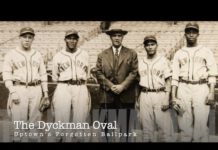Baker Field, the Columbia boathouse and the giant aqua-marine “C” painted on the rock wall of the Spuyten Duyvil…all are neighborhood landmarks and part of the social fabric that make Inwood so special.

But how did Columbia University, with its main campus over 100 blocks away, wind up with a sprawling sporting complex in Inwood?
First let’s explore the previous occupant of the property.

On the site currently occupied by the Chrystie Field House once sat the three story mansion of Isaac Michael Dyckman. The Dyckmans, along with the Nagles, first settled in Inwood in the 1600’s. Both families now have streets named in their honor. Dyckman’s nineteenth century mansion stood on the site until 1950 when the home was demolished to make room for the current Chrystie Field House.
But, let’s step back for a moment. It turns out Columbia University wasn’t the first group with plans for the property.
Take a look at this map from 1911. Where Columbia’s twenty-six acre sports campus now sits is a very curious site. Instead of the familiar placing of Columbia the map indicates a strange and unfamiliar name…”Wonderland.”

It turns out that around the turn of the century a group of investors got together and agreed to pool their money on what might be described as the Coney Island of northern Manhattan. The site had plenty of “beach-front” real estate, New Yorkers at the time were very fond of public bathing, and sweeping river views in both directions. Early plans included a ferry terminal and amusement park style rides, the land was even leased, but by 1904 the deal had fallen apart. The land, it seemed, was up for grabs.
 Enter Park Avenue banker George Fisher Baker, Jr.. By 1877 Baker had made his fortune as president of the First National City Bank. If the name sounds familiar, it is. The little bank where Baker began his career in 1863 is now known as Citibank.
Enter Park Avenue banker George Fisher Baker, Jr.. By 1877 Baker had made his fortune as president of the First National City Bank. If the name sounds familiar, it is. The little bank where Baker began his career in 1863 is now known as Citibank.
In 1921, using money donated by Baker, Columbia University purchased the site and development soon followed. One by one, Columbia’s athletic programs began their uptown migration. Soon shouts from Columbia alumni and local fans would echo across 218th Street.

The Boathouses

By the late 1920’s, Columbia’s crew team became familiar faces on local waterways with the completion of the old Gould-Remmer boathouse. The new facility, called the Class of 1929 boathouse, after the last class to win the national championship, was completed in 2001. The new facility boasts three 21 by 76 foot boat storage bays and a 2,000 square foot aerobic training room for the rowers.
Baker Field

College football arrived in Inwood in 1923 and the 1928 completion of the old Baker Field soon followed. The old wood seat stadium soon became a premier destination for collegiate football, as well as baseball, and served the neighborhood well for 55 years.

On May 17th, 1939 Baker Field made television history when NBC reporter Bill Stern broadcast the world’s first live sporting event, the second game of a baseball double-header between Columbia and Princeton. A New York Times reporter later complained that the players looked like “white flies running across the screen.”
According to the description accompanying the above press photo released by NBC, “On May 17, 1939, Columbia played host to Princeton in a game that transcended the Ivy League standings in terms of historical impact. That game was unique because a single NBC camera, perched precariously on a wooden stand overlooking Baker Field in Manhattan, was making television history. A sporting event was being televised for the first time, and the late Bill Stern (lower right) called the play-by-play for NBC.”

Today’s new Lawrence A. Wein Stadium, which became the Robert K. Kraft field after a $5 million donation, opened its gates in 1984 and seats 17,000 sports fans. New artificial turf was added in 2005. Today’s Columbia Lions now practice and compete on the same FieldTurf as many NFL teams.

The ever changing intersection of 218th and Broadway



Assorted Baker Field ephemera:






















Excelente labor de investigacion y periodistica.-He conocido,a raiz de haber estudiado en la Columbia University,hace algunos años, todos los lugares que menciona el autor.Felicitaciones
I was wondering if you have any photos of the caretaker house that sat below the stadium in Baker Field. My Grandfather, John McManus was the caretaker for many years till his death in 1964. I have no photos of the outside of the original house I was hoping you could help me find one. I believe the house was torn down to make room for the new stadium in 1982. Thank You for any help you might be able to give in this matter.